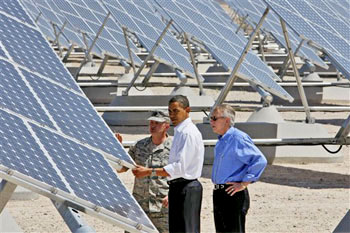|
from TheExaminer Website
“Renewable energy sources,” according to a leading national electric grid expert, can be an “important lifeline":
John Kappenman has 32 years experience in the electric power industry, and spoke at a Space Weather workshop convened by the National Research Council (NRC) in May 2008 to understand “the societal and economic impacts of severe space weather” on the U.S. electric grid.
One of the themes discussed at the workshop was the impact of increased solar activity as Solar Cycle 24 becomes most active around 2012.
Kappenman’s findings were incorporated into a report (Severe Space Weather Events) later published by the National Research Council in December 2008.
President Obama inspects solar energy panel at Nellis AFB. Photo: AP
More recently he spoke at the Space Weather Enterprise Forum 2009 held from May 19-20.
Kappenman’s primary concern was that in a severe solar storm electrical transformers can be damaged causing power blackouts for extended periods. Repairs to the damaged electrical grid could range from several weeks or months in some cases.
In more extreme cases involving badly damaged transformers, according to Kappenman, repair times could extend up to a staggering “four to ten years.”
On June 2, I spoke to Kappenman to get his insights on:
I began by asking Keappenman about NASA’s announcement in December 2008 of the discovery of a giant breach in the magnetosphere allowing up to 20 times the normal rate of solar plasma to enter into the Earth’s atmosphere.
NASA’s announcement revealed that that the breach would last for the full 11 year period of Solar Cycle 24 (approx. 2008-2019) thereby making the electric grid very vulnerable to any Coronal Mass Ejections directly aimed at it from the sun.
Kappenman acknowledged that NASA’s announcement of a large breach in the magnetosphere added,
If scientists were already concerned about the electric grid vulnerabilities, the December NASA announcement only compounded the threat level. Kappenman is not a big believer in 2012 being a pivotal year given that is the year the sun is scheduled to become most active in terms of sunspots.
In responding to a recent NASA estimate that Solar Cycle 24 would not be as active as first thought around 2012, he said:
Kappenman is cited in the NRC report as saying that the most vulnerable part of the electric grid are electrical transformers:
The NRC report further cited Kapperman’s estimate that the financial
cost for severe space storms was “$1 trillion to $2 trillion during
the first year alone” (p. 4). The financial costs for a state the
size of Hawaii has been estimated to be approximately
one billion
dollars a week.
Kappenman pointed out that states that operate with lower voltages and smaller sized electrical grids such as Hawaii,
Any damages to the Hawaiian grid system might
nevertheless suffer from delays in receiving replacement parts due
to higher priority given to more severely damaged grids on the U.S.
mainland.
In an interview with Wired Science he said:
In our June 2 interview he said that the resistors were effective in “reducing GIC levels on average by about 60%.”
That would eliminate
the threat to many transformers “considered at risk” but he pointed
out “that there should be additional safety measures considered as
well.” These include “independent power sources and the ability to
operate isolated from the power grid.”
He first pointed out the challenge in going beyond the approximate 3% of renewable energies currently used. He emphasized the need to mitigate potential damage to the electric grid itself since this is how most electricity is transmitted in the U.S.
He then went on to say:
In explaining how off-the grid energy sources offer a layer of protection against electric grid collapse, Kappenman responded:
Kappenman finally pointed out that,
He pointed out that large solar storms are,
The possibility of solar storms bombarding the Earth and taking down the electrical grid in the U.S. and other countries for extended periods needs urgent consideration.
Regulation of electric utilities occurs at a state level in the U.S. State legislatures and Public Utility Commissions need to immediately start studying the impacts of severe solar storms and introduce public policy to deal with their impact on local electric grids.
Developing renewable energy generation sources that are not dependent on the electrical grid and include non-conventional technologies such as "free energy generators" offer an important lifeline in case of electric grid collapse.
Governments at the local, state and federal levels need to consider legislation that will ensure that essential services, industry and consumer needs are safeguarded in the event of an electric grid collapse for extended periods.
from YouTube Website
|

